#like the beluga whale sanctuary has
Text
I’m starting to feel like it’s a legitimate possibility that Wikie and Keijo will end up as the very first orcas to be transferred to a sea sanctuary. Combine the untimely deaths of Moana and Inouk and a financially troubled park with the blocked transfers to Japan (and the new park has already started taking in whales from other Japanese facilities, so I don’t think they’re waiting for them) and a government that’s eager to offload its cetaceans, and you’ve got the perfect recipe.
I hope it works.
#I don’t think it will#but for their sake#I hope it works and I hope they thrive#but they’ve never known a world beyond that pool#if the mla facilities are truly in as bad a shape as they say… tell me how keeping them there for several more years#while the sanctuary is built#is better than sending them to a brand new albeit smaller facility#I really don’t think it is#but please… please build a land based habitat on site#like the beluga whale sanctuary has#if not for it they would’ve lost both their whales#whale sanctuary project#marineland antibes#orcas#killer whales#wikie#keijo
15 notes
·
View notes
Note
God, I fucking hate the morons that go "Here come the dummies making comments about animal abuse!!! It's called conservation, sweaty <3" because they're so fucking obnoxiously uneducated, it's not even funny. Like you said, REAL conservation sites will not let you feed the animals, for one thing, and I also literally volunteer at a raptors rescue center in which TONS of our birds had to be rescued from horrible fucking "owl cafe" type locations in which the birds are neglected and treated like decorations rather than living fucking creatures. These people have LITERALLY NO IDEA how bad these places are for the animals, and yet they pretend like they do, they're literally telling on themselves by showing how fucking stupid they are. In an ACTUAL conservation center like mine, we do have flight shows and we have SOME birds that we allow customers to pet and hold (ones that have been with us for years and that we know have the temperament for it, as well as it having to happen with a staff member present and not for long periods of time) but after that, they get put back into their own enclosures. Repeat, ENCLOSURES, that are large, and with space for them to move and fly as they please. Not one fucking stick that they're goddamn chained to for people to gawk at. These people are tone-deaf, brainless idiots if they genuinely believe those cafes are suitable environments for wild animals. To all Vivzie stans that are defending her support of these places, from the bottom of my heart, fuck you, you horrific, awful, animal abuse enablers. That is what you are, no matter how much you yell and cry that it's not. Fuck you.
It's absolutely maddening. The smug "um, it's called conservation sweaty, it's being rehabilitated in a sanctuary" remarks on the false killer whale burned me the most because cetaceans are my thing in the way birds are yours and there are very few real sanctuaries for cetaceans.
One is the Umba Lumba Center in West Bali, which rehabilitates and releases show dolphins and cares for those who can't. The beluga whale sanctuary in Iceland is another. They're trying to set up one in Nova Scotia, and the Baltimore Aquarium has (ostensibly) been trying ever since 2016.
Okinawa Churaumi Aquarium, where Viv visisted, is not one of these. Okinawa Churaumi keeps Taiji dolphins.
50 notes
·
View notes
Text
In case anyone's wondering, I'm pro-captivity in theory and mostly in practice. Every zoo or sanctuary has the ability to be bad at their job, but ordinarily I trust AZA for telling me what places are trustworthy with animals and what ones aren't.
Still, I'm side-eyeing any standard zoo that has these particular animals, given that I'm not certain every* zoo/aquarium is equipped to take care of these speciess' specific needs:
Great Apes (chimps, bonobos, orangutans and gorillas. idk about Gibbons)
Dolphins and orcas
Hippos
Whales (belugas, narwhals, ect)
Rhinos
Elephants
Polar bears
Cassowarries
Emperor and Adele penguins
Whale sharks
Basking sharks
Tigers
this isn't to say these animals can never be held in healthy, happy man made environments. I just think there's a big different between taking care of a small herd of cows vs a rescued elephant, let alone several rescued elephants. Elephants are traumatized+ill and need to best treatment after years of abuse in shows. They need socialization and LOTS OF lots of space, even more than cows or other grazing animals that are mostly independent and just need a vet to come up to them every now and then.
And then you have animals that need a really good upkeep of what they'd have in the wild to not be miserable, like any animal from the poles or cetaceans, who need so much space, cold air and food and it's abuse to keep them in anything lacking in these areas.
8 notes
·
View notes
Text
Nova Scotia's retirement home for captive whales facing obstacles, delays: documents
An ambitious plan in Nova Scotia to build North America's first coastal refuge for captive whales is at least five years behind its original schedule, newly released documents show.
The project, announced in February 2020, calls for construction of a 40-hectare underwater enclosure that would provide a natural environment for beluga and orca whales retired from marine parks. It would be as large as 50 football fields and about 300 times larger than the biggest captive whale tanks.
Organizers behind the U.S.-based Whale Sanctuary Project had originally predicted the site on Nova Scotia's rugged eastern shore could be ready to receive whales this year.
But the COVID-19 pandemic, regulatory hurdles and environmental concerns have slowed the project's progress, according to documents obtained by The Canadian Press under the province's freedom of information law.
An internal government presentation prepared in May 2021 says that once the project is granted a Crown lease for a small cove and some land south of Port Hilford, N.S., it would take at least another five years before the site is ready to accept whales. That pushes the start date to 2027.
Charles Vinick, executive director of the non-profit Whale Sanctuary Project, said the government's timeline is flawed because it includes construction of an interpretive centre, which won't happen until after the whales arrive. The group's own timeline now has a late 2023 start date, though Vinick said 2024 is more likely.
The pandemic is largely to blame for slowing down the project, but Vinick also pointed to a demanding provincial permitting process.
"It's brand new ground for them and brand new ground for us," he said in an interview from his home in Santa Barbara, Calif. "We have to focus on moving forward every day."
As an example, he cited his group's plan to extract small core samples from submerged soils for testing. A permit application was filed in April, but it took almost five months for the Department of Natural Resources to decide that an archeological assessment was required before the testing could start.
"These things do come up, and I suspect there will be more," Vinick said. "But every time one comes up, we're going to do it."
The documents also point to serious concerns about 20 abandoned mine shafts and contaminated tailings left behind from nearby gold mines that operated between 1862 and 1900.
The sanctuary project says recent work has identified some shafts that remain unfilled on or near land that the project plans to occupy, and soils throughout the property have been analyzed. More testing will determine whether any areas require mitigation.
"All mitigation requirements that will be assessed, we will meet," Vinick said. "We're not going to do anything to jeopardize the health of the whales."
On another front, the documents show that Nova Scotia's Environment Department was concerned about nearby wetlands, and the federal Department of Fisheries wanted to know what kind of animals would be admitted to the refuge to allow officials to prepare for disease mitigation and an application under the Species at Risk Act.
As for the 40-hectare enclosure -- to be surrounded by underwater nets -- it will be designed to hold eight to 10 beluga whales and two to three orcas in a separate area. The animals will not be returned to the wild because of their lack of survival skills.
The $20-million project, which will rely on private donations for support, also calls for the construction of a veterinary clinic, observation tower and other support buildings. Another $2 million would be needed annually for operations. A visitor centre was opened last year.
About 200 belugas and 50 orcas are being kept in marine parks and aquariums around the world. The Marineland Park in Niagara Falls, Ont., has about 35 belugas and Canada's lone captive killer whale, Kiska.
"None of this work can happen soon enough for the whales who are languishing in concrete tanks and are subject to intolerable conditions," the group said in an online post last month.
"Yet it is essential to get everything right for the health and safety of those very whales when they are introduced to an entirely new life. It is also the law."
This report by The Canadian Press was first published Oct. 23, 2022.
from CTV News - Atlantic https://ift.tt/65YyOP9
0 notes
Text
wow look another au
I swear this is the last one
The Mermerc AU Universe:
All the mercenaries are merfolk or something similar.
Honestly, that’s it. I have no lore or anything.
Potentially, they could be living in a sanctuary where Miss Pauling (and possibly the Reader if we insert one into the story) are assigned to take care of them, or possibly a center for the exchange of information between the two races? Idk honestly
They all typically eat the diet of their fish species, but can eat other foods.
Merfolk typically vary in sizes a lot more than humans. I will talk about their heights here. But since tails also vary in length, the height I will mention would be their height IF THEY HAD LEGS. So don’t think the height I mention is their actual length, it’s more for being able to visualize their general size compared to normal people.
Mermerc!Scout:
Common Bottlenose Dolphin
70 in
Incredibly skilled and fast swimmer despite being a lot smaller than the others, loves to flex this fact and race anyone who will race him.
Has a few small scars from fighting merfolk from other pods.
Has an almost child-like fascination with the human world and wishes he could see it himself.
Mermerc!Soldier:
Great White Shark
74.5 in
Has sharp teeth and often shows them off when he jokes about eating one of the others, but he’d never do that.
He’s been in a whole lot of fights, so he has a lot of scars all over his body.
Unlike normal sharks, he can stop moving and prefers to while sleeping.
Mermerc!Pyro:
Mexican Squirrelfish; red variety
69 in
Still has a fascination with fire, loves to sit on the shore with visiting humans if they have a bonfire.
Hates going into deep water, partly due to being smaller like Scout, and likes to stay in reefs or near the shore, and likes visiting humans.
Incredibly playful and loves games. Kinda the baby of the group.
Mermerc!Demoman:
Selkie; Grey Seal
73 in (Actual height, as his form is fully human)
Due to being a selkie, he does not have a half and half form; he has a full human form and a full seal form, so he can go on land, and does so regularly.
The colony he came from was basically the DeGroot clan; his parents were part of the leading group and he was a warrior.
Mermerc!Heavy:
Beluga whale
79.5 in
Has allowed his sisters to go explore, but his mother often stays with him
Of course, he’s had to defend his family from the dangers of the open ocean, so he’s had to fight off many predators and has a pretty scarred up body. It’s kinda easy though, as he’s a bigger than canon Heavy and the biggest one any of the others have met.
Mermerc!Engie:
Clownfish
66 in
He’s easily the smallest member of the group. That combined with not being a great fighter makes him pretty vulnerable.
He’s pretty curious about humans’ advancements, especially technology and science. He’d be able to pick it up very easily if someone were to teach him about it.
Mermerc!Medic:
Lionfish
76.5 in
He’s got a beautiful tail and breathtaking fins, and he knows it. He often flaunts his appearance and loves to show off, to humans and merfolk alike.
He’s probably revolutionized merfolk medicine, even though he obtained it through less than humane means.
Mermerc!Sniper:
Tiger Shark
77 in
Kind of suspicious of humans; he was probably trapped and almost taken by humans once, which gave him a few scars on top of several fight scars. One could gain his trust over time, though.
Doesn’t get along well with most of the others, but sometimes he chills with Spy or Scout.
Mermerc!Spy:
Mimic Octopus
72 in
Kind of elusive; he hides out pretty often and doesn’t like some of the others, but there are quite a few humans he likes to come to shore and talk with.
He can’t hide his face, so most people can see the scars he has on his face. He refuses to talk about them.
#tf2#teamfortress2#tf2 au#ens mermerc au#tf2 scout#tf2 soldier#tf2 pyro#tf2 demoman#tf2 heavy#tf2 engineer#tf2 medic#tf2 sniper#tf2 spy#tf2 imagines#tf2 headcanons
197 notes
·
View notes
Photo
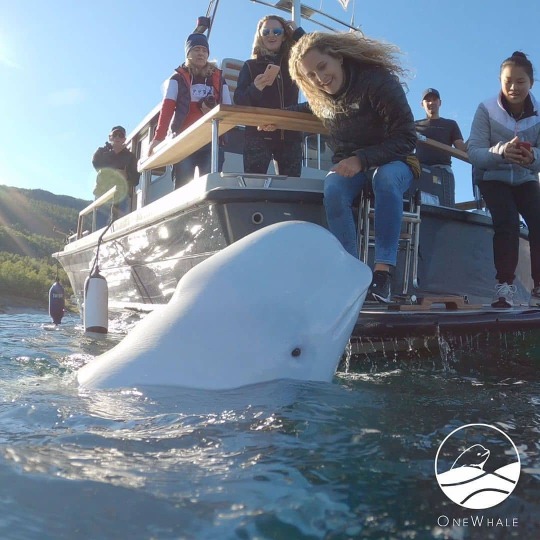
Meet Hvaldimir, the formerly captive beluga whale! He was wearing a harness when he was found by Norwegian fishermen and was suspected to be a Russian spy whale. Hvaldimir now roams the Norwegian fjords on his own, often trying to interact with humans, his only source of companionship, as well as a potential danger to him. He willingly approaches boats, which has already caused him a collision with a propeller and an ugly injury.
Hvaldimir cannot end up in a tank, he’s a free whale, but he’s alone out there, so he does need help. That’s why @onewhaleorg is trying to grant him (and other wildlife in need) a sanctuary where he can be safe, in one of Norway’s fjords.
If you’d like to help Hvaldimir, the lonely beluga, you can go to https://www.onewhale.org/take-action and send a pre-written email to the Norwegian government. Hoping this lonely guy will get a safe home in the near future! 🌊🐳
#just recently found out about these guys#and what they are doing is amazing#Hvaldimir the beluga#hvaldimir#beluga#whales and humans#marine life#wildlife#conservation#awareness
126 notes
·
View notes
Video
LUMPSUCKER or LUMPFISH
Cyclopterus lumpus
©Laura Quick
While I had hoped to see them swimming aimlessly around, the lumpfish, true to form were suitably, well, lumpy. They are kind of cute in their own way. This one, is bluish in color and lives at the Sea Life Trust Beluga Whale Sanctuary / Sæheimar Aquarium in Heimay, on the Vestmannaeyjar in Iceland.
Lumpfish generally have bodies that are ball-like. They have a knobbly, ridged back and three large bony tubercles on each flank. Their pelvic fins form suction discs which it uses to attach strongly to rocks or other surfaces. The head and the pectoral fins of males are larger than those of females. It has a jelly-like layer of fat under the skin. Its color is highly variable; bluish as this one, greyish in the link below, olive, yellowish or brownish. Mature males turn orange-reddish during the breeding season.
Other posts you might like:
Pacific Spiny Lumpfish
Grey Lumpfish
Lumpsucker
Pygmy Leatherjacket (not a Lumpfish - but cute)
#lumpsucker#lumpfish#cyclopterus lumpus#©laura quick#sea life trust#sæheimar aquarium#heimay#vestmannaeyjar#iceland#fish#cute#pectoral disk#adheres to surfaces
156 notes
·
View notes
Text
Thank you😊❤️❤️❤️❤️
Belugas

The beluga is an icon of the sea. The porcelain body is recognisable at a glance, but few are aware of the whale’s amazing abilities and propensity for making the news. From talking like a person and sharing a rare biological quirk with humans to carrying military equipment to surprised fishermen, belugas are more than just cute faces. They have a bubble language, adopt other whales, and apparently have a job somewhere in the Russian forces.
One visited the Thames

Belugas are Arctic animals, but one made his way to the River Thames in the United Kingdom. Nicknamed “Benny,” he attracted quite a following upon his arrival in 2018. He appeared to be a subadult that took a wrong turn somewhere, but Benny’s behaviour showed he was in good form. The beluga fed and explored the Thames for days while fans gathered on the banks and animal welfare organisations kept a constant vigil. The Port of London Authority (PLA) also gave the whale the right of way.

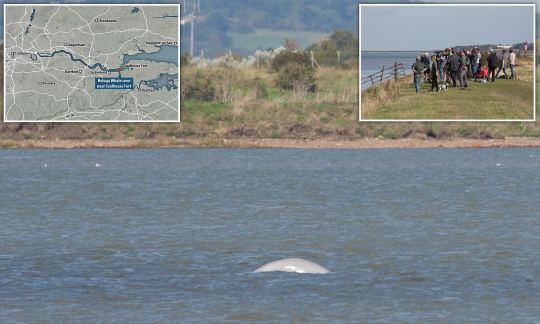
PLA urged all waterborne vessels and companies to avoid the odd visitor. Belugas are as much at home in rivers as in the ocean, which was probably why this one took a fancy to the Thames. In fact, Benny stayed for months.
They experience menopause
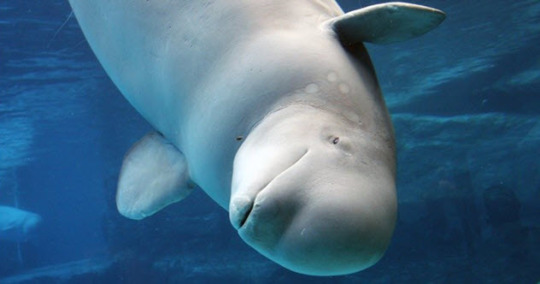
Humans and certain whales have an odd thing in common—menopause. The rest of the planet remains fertile for as long as they live. In 2018, it was discovered that both narwhals and belugas experience menopause. This increased the tiny club to five members—humans, orcas, short-finned pilot whales, and the two new additions.

As life is about reproduction, menopause is a bit of a mystery. Women and whales live for decades after their fertility ceases. Technically, they could have had a lot more offspring. But as they grow older, they might be more valuable as grandmothers than experienced females occupied by yet another infant of their own.
Over the years, anthropologists gathered enough evidence that grandmothers are instrumental in helping grandchildren thrive. She brings the knowledge and time that her own children might lack as new parents. Orca mothers keep feeding their adult sons, probably to increase these males’ chances of producing offspring. Unfortunately, the habitat of belugas and narwhals are too remote for the multigenerational study needed to see if their grandmothers bring anything to the table.
A natural retirement home
youtube
Little Grey and Little White were both born in captivity. For the last seven years, the belugas entertained visitors at a Chinese water park. The fact that they lived in a concrete tank did not make animal rights activists very happy. However, it was not as easy as dumping the pair back into the ocean. To hurl a captive-born-and-raised beluga into the sea will kill it. Recently, a conservation group called Sea Life Trust came up with the answer. The organisation created a world first—an open sea haven for whales and dolphins. More specifically, it was a retirement home for oceanic animals leaving show business.
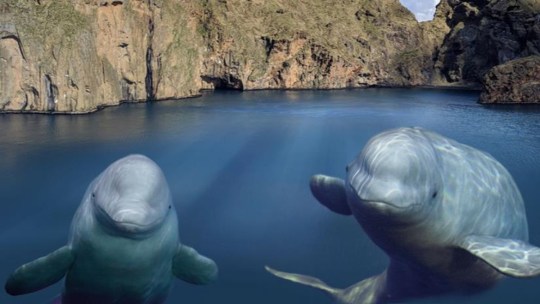
Located near Heimaey, an Icelandic island, the sanctuary forms part of the local bay. In 2019, the 32,000-square-meter (344,000 ft2) area welcomed the belugas as the first retired entertainers. Both aged 12 years old, they underwent survival training before their release, which will hopefully see them spend the next 40 years or so in a safe habitat.
Cat poop is a danger

Between 2009 and 2012, around 34 belugas died in Canada’s St. Lawrence Estuary. In 2018, scientists had a look at the hearts and brains of these animals. The tests were designed to screen for a parasite called Toxoplasma gondii.

This devastating pest causes toxoplasmosis. The condition affects animals neurologically and has been found in fatal cases involving other whales and dolphins.
The analysis showed that 15 of the belugas were infected. T. gondii is a common cat parasite. It is notorious for spreading to other species, usually through contact with feline feces. It is thought that marine animals living near freshwater outflows into the sea, like the St. Lawrence pod, face a greater risk of infection. Many people tend to flush their cat’s litter down the toilet. The parasite is resistant to sewage treatments and then flows downstream toward the ocean. Even though T. gondii has also been identified as the killer of monk seals and sea otters, researchers could not determine if this was the cause of death for the 15 belugas.
Beluga bubbles
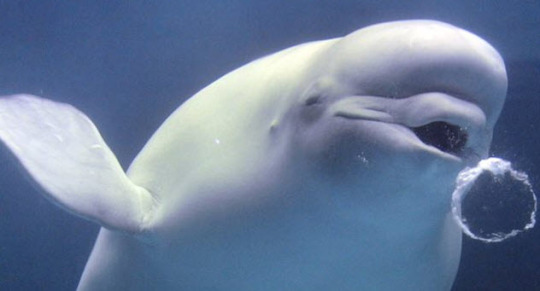
At Marineland of Canada, researchers took eight years to stare at 44 belugas. The reason? To unravel the whales’ most whimsical side. Belugas love blowing bubbles, but the sheer variety suggests communication. Bubble blowing has rarely been observed in the wild and never compared to those of aquarium whales. There is always a chance that captivity could change communication, but here is what they’ve figured out so far.
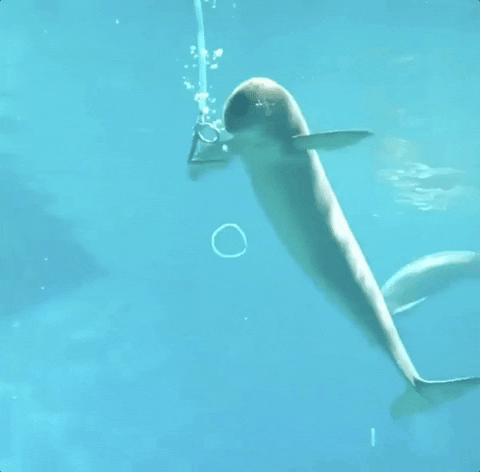
Certain bubbles appear to reflect certain states of mind. Females are more playful and release bubble rings or a slow froth of tiny bubbles more often. One of the most impressive displays is a huge bubble ring through which the beluga often swims.

The Marineland belugas shoot water jets at the rings or swat them with their tails. Bubbles seem to double as communication and a fun hobby. However, when feeling threatened, the whales forcefully expel bubbles from their blowholes as a clear warning to back off. Some bubbles remain undeciphered. Researchers still do not know why males cruise alongside each other while releasing a steady stream of bubbles.
The honorary beluga
youtube
In 2018, researchers visited Canada’s St. Lawrence River. They wanted to learn more about belugas’ social behaviour and got more than they bargained for. The group of 50–60 whales was believed to be a bachelor pod or at least mostly male. What the scientists did not expect was the presence of a young narwhal male. This whale species is famous for its unicorn-like tusk. The belugas appeared to have adopted the subadult even though he had a horn, had a dark gray body, and was a foreigner that normally swam 965 kilometres (600 mi) north of the river. They even played games.


Narwhals have unique body marks. When this one’s patches and scratches were checked, the scientists realised that it was the same one that had frolicked with the St. Lawrence pod in 2016 and 2017. This long-term bond is unusual because the two species rarely make an effort in the wild to interact. Even when belugas and narwhals cross paths, the moment usually passes.
The dolphin-speaking beluga

In 2013, a group of dolphins got the fright of their lives. Housed at the Dolphinarium Koktebel in Crimea, the latest addition to their tank was a beluga. Her white body was enough to scare the bottlenose dolphins, but worse, she sounded funny. The dolphins could not speak “beluga,” and the newcomer could not speak “dolphin.” That changed quickly. The new girl settled in and was accepted. Within two months, the beluga whistled like a dolphin. In that time, the whale phased out her own native tongue and eventually dropped beluga calls and sounds entirely. She even used “signature whistles,” which equate to an individual’s name among dolphins.

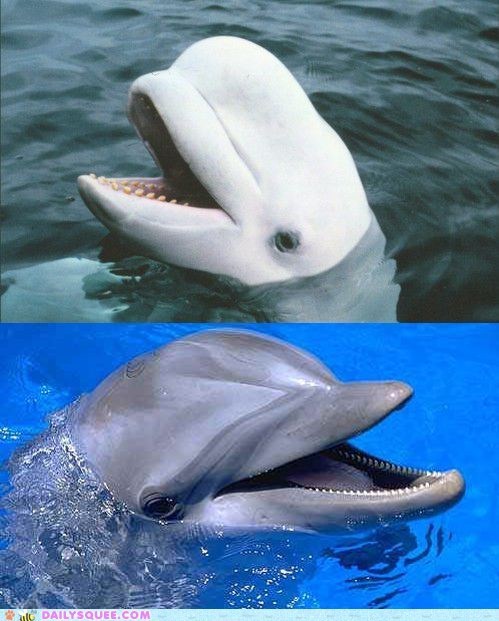
This is an amazing feat, undoubtedly driven by the fact that belugas are powerful mimics and social animals with a desire to fit in. Researchers are not sure how much is mimicry and how much “dolphin” the beluga actually understands. One thing was clear, though. The dolphins accepted their strangely pale friend but made no attempt to learn or imitate her native language.
The amazing Noc

Imagine diving at the National Marine Mammal Foundation in San Diego. Then somebody tells you to get out of the tank. However, the only mouth nearby belongs to a beluga called Noc. This really happened in 1984 when researchers began hearing “human conversation” from the area in which they kept the dolphins and whales. They managed to narrow the sounds down when the diver heard the word “out” and the scientists realised that the vocalisations came from Noc. He apparently picked up a few words after listening to staff conversations.

Thoroughly encouraged by snacks, the beluga repeated his human sounds into a recorder. The analysis revealed interesting facts. To produce the sounds, Noc had to use parts not normally used by whales when they communicate. He adjusted the air pressure in his nasal tract, manipulated liplike valves, and overinflated air sacs beneath his blowhole. Researchers had never heard anything like it. His vocal rhythm was similar to a human’s and not typical for a whale at all. Beluga whales are great mimics and so vocal that they are known as the “canaries of the sea.” Even so, Noc’s feat remained remarkable.

https://youtu.be/VNz01X8XlmA
61 notes
·
View notes
Link
How about focusing on the current belugas you have that haven’t even been moved into their sea open before campaigning to “free” the other 300 in human care. We don’t know yet how the long term care costs are going to work out or how these whales will adjust to their new environment. Not to mention their beluga sanctuary can hold 12, so where are the other 290 going to go? The National Aquarium has been looking for a place to build a sea pen for their dolphins for almost four years now with no luck. How about campaigning to clean up our oceans or fighting climate change?
I still hope all goes well for Little Grey and Little White, and look forward to following their journey. I just do not feel like the beugas in human care would be better off in sea pens.
#beluga#belugas#beluga sanctuary#sea life trust#the 300#Merlin Entertainment#cetaceans#captive cetaceans
4 notes
·
View notes
Photo

Sanctuary proposed for captive orcas
The Islands’ Sounder - July 12, 2019
Feared by whalers who watched them feed off dead whales they were hauling to their ships, orcas were called killer whales. Later, captured, forced to perform tricks, these animals are now revered, as they have always been by indigenous peoples, and sea aquariums are now facing pressure to release them.
“The public viewpoint is shifting, as it did with large animals in zoos, like elephants “ Lori Marino, president of The Whale Sanctuary Project, said.
The Whale Sanctuary team will present their proposal to the public, along with unveiling several site possibilities, two of which are located in the San Juans on Sunday, July 21, 2-4 p.m. at Brickworks in Friday Harbor; Orcas Island on Tuesday, July 23, 7-9 p.m. at the Emmanuel Episcopal Church; and Lopez Island at the Woodmen Hall on Wednesday, July 23 ,7-9 p.m.
“We are still in the process of talking to stakeholders. We want to make sure we do due diligence,” Marino said, explaining that the group was not quite ready to give the logistics out.
The concept for a whale sanctuary is to provide an area where cetaceans currently in captivity, like Tokitae, who was taken from the Salish Sea as a four-year-old calf, away from her Southern resident L pod in the ‘70s, can retire in a larger, more natural setting. Captivity has been known to have negative health effects on cetaceans. In the wild, orcas life expectancy is on par with humans. Granny, a matriarch from J-pod lived to be an estimated age of 100-plus years old. In captivity, however, Marino said, on average orcas only live 20 years.
In the wild, cetaceans swim hundreds of miles each day and dive deep beneath the waves. In captivity, the tanks are often so small they can only swim the length of their body before they have to turn around. The tanks are shallow, subjecting them to sunburns, and boredom drives them to chew on the metal grates, breaking and wearing down their teeth. Countless orcas have killed themselves by ramming their heads against the sparse concrete aquarium sides.
In the article “The Harmful Effects of Captivity and Chronic Stress on the Well-being of Orcas,” in the Journal of Veterinary Behavior in May of this year, Marino, along with fellow scientists Ingrid Visser, Naomi Rose, Heather Rally, Hope Ferdowsian and Veronica Slootsky wrote, “Observations of orcas reveal that they experience deep emotions and strong social attachments. These observations include reports of long-range contact, calling when separated from others, grieving behaviors, and helping, ephimeletic, behaviors.”
The paper described several instances of grief and generosity scientists have witnessed in wild orcas.
One such example was Tahlequah, a Southern resident female whose baby died shortly after birth. Not only did she carry her baby’s body around for 17 days, but her other son was seen helping her carry it, and other members of her pod shared food with her as she did not appear to be hunting during that time.
Frequently, in captivity orcas are kept alone, as Tokitae is in the Miami Seaquarium, giving them no social interactions and furthering their stress. “The Harmful Effects of Captivity” study explained that these chronic stresses in captive orcas cause their immune systems to weaken, thus usually harmless pathogens can make them seriously ill.
Stress also can cause behavior issues making the animal aggressive or neurotic, according to the article.
Tokitae is now over 50 years old, one of the oldest captive orcas. According to Marino, there are reports she is losing her eyesight.
“We have not verified that,” Marino noted, adding that Tokitae has been incredibly resilient.
Should Tokitae become one of the animals able to retire in the sanctuary, they would need to know everything possible about her health so veterinarians could know how to best care for her.
“We would love to have her, to bring her back to her natal waters,” Marino added.
The sanctuary project group has been working with Lummi Nation to see if, at the very least, Tokitae can be brought back to her home. Releasing her back with her pod would not be out of the question either, should she be in good health, however, Marino cautioned, not only is there a lot of work filled with maybes and what ifs before a release, but they would need a permit from the National Oceanic and Atmospheric Administration.
Unlike a net pen, which is a small closed-off sea area, a sanctuary will provide enough space for about half a dozen animals, and be 100-times larger than the largest existing aquarium tank, Marino said. Depending on where the final location, there will be a visitors center where the public could watch the orcas remotely, from a video, behaving a bit more the way they would in the wild. Also, depending on the site, Marino would like to have a nature trail around the sanctuary, where the public could walk and view the animals from a distance. Another key feature, Marino said, is that the facility would have a fully staffed and equipped veterinary area, including an isolation area to protect the sick or injured citation, as well prevent the healthy animals from being exposed to pathogens.
Marino, who was involved in the attempts to rehabilitate the ailing orca Scarlett last summer, said one lesson from that incident was the need for a facility near the Southern residents where, should another resident need urgent care, emergency treatment could be provided quickly without hassle. Once rehabilitated, the whale would be reunited with its pod, Marino added.
“The animals in the sanctuary will need full-time veterinary care anyway, so it wouldn’t be a big stretch to have it available for sick or stranded wild animals,” Marino said.
Orcas are the third most common cetacean in captivity, dolphins and belugas being the first two. Captivity has had similarly reported health effects on them as well.
The idea for a sanctuary came to her during a conference on captive cetaceans.
“I just thought we need to do this,” Marino said.
As she began reaching out to others, the program grew to having between 50-60 advisors as well as a full board. Many are experts in marine mammal biology, or the laws pertaining to them.
“Everyone I talked to said yes,” she said with a laugh.
The group includes several renowned researchers and activists, including Paul Spong, founder of OrcaLab in British Columbia; Visser, a scientist and founder of Orca Research Trust; and Jean Michael Cousteau, son of Jacque Cousteau, a filmmaker and ocean advocate.
“In the beginning, I thought how is this ever going to happen,” Marino added. “It happens when you get people together.”
The general public, she continued, has also been very supportive.
“I think people know the animals are not doing well in these parks, and they want an alternative,” Marino said.
SeaWorld and its counterparts have had a wide range of reactions, although no one has agreed to give up one of their animals.
“No one has said you won’t ever get a whale,” Marino said, adding that keeping the lines of communication open is key.
“We want [aquariums] to know we will continue talking to them, and listening to what they have to say,” she said, adding that they feel pressure, and know the sanctuary offers a new way of doing things.
With hundreds of captive animals around the world, this one proposed sanctuary is just the beginning. While the sanctuary project does not have the resources to create sanctuaries everywhere, however, should they be successful, Marino hopes people around the world could use their facility as a model.
“I think this could be a real game changer,” she said.
25 notes
·
View notes
Link
Excerpt from this story from Mother Nature Network:
These are turbulent times for the Arctic. Not only is it heating up about twice as quickly as the rest of the planet, causing a disastrous decline of Arctic sea ice, but it's also increasingly vulnerable to environmental harm from activities like mining, drilling and fishing.
In hopes of buffering a swath of the Arctic from this upheaval, Canada is creating two new marine sanctuaries in the Arctic Ocean spanning a total of 427,000 square kilometers (165,000 square miles). This alone may not protect the region from climate change, but the Arctic needs all the help it can get, and well-managed ocean preserves can be a significant boost for struggling ecosystems.
The largest of the two new sanctuaries — Tuvaijuittuq Marine Protected Area (MPA), covering about 320,000 square kilometers (124,000 square miles) off the northern coast of Ellesmere Island in Nunavut — was announced by government officials on Aug. 1. The name Tuvaijuittuq means "the place where the ice never melts" in the Inuktitut language, referring to thick, multiyear sea ice that persists throughout the summer. Tuvaijuittuq is located in an area long used by Inuit for travel and hunting, although there are currently no permanent human settlements within or adjacent to the new sanctuary, according to a government fact sheet.
Dubbed the "Last Ice Area" by conservationists, this region is expected to be the last place that retains summer sea ice until climate change renders the Arctic Ocean ice-free in summer, which may happen within just a few decades. That makes it an important refuge for sea ice itself, which has benefits that go far beyond the Arctic, as well as local wildlife that depends on it.
Under the ministerial order that designates the Tuvaijuittuq MPA, no new human activities will be allowed to occur in the area for up to five years, with a few exceptions. These include the exercise of Inuit rights for wildlife harvesting, scientific research consistent with the MPA's conservation objectives, and activities related to safety, security and emergency response.
While the unveiling of Tuvaijuittuq is a first step for that MPA, Trudeau and other officials also announced the completion of another ocean refuge, known as the Tallurutiup Imanga National Marine Conservation Area, that has been in the works for years.
Located south of Ellesmere Island, Tallurutiup Imanga protects about 108,000 square kilometers (42,000 square miles) of priceless marine habitat and cultural context in Lancaster Sound and Baffin Bay between Devon and Baffin islands.
"It is a large natural and cultural seascape that is one of the most significant ecological areas in the world," according to Parks Canada. "It is critical habitat for species such as the polar bear, bowhead whale, narwhal and beluga whale. For Inuit living in the region, called both Tallurutiup Imanga and Tallurutiup Tariunga by the Inuit, it is a place rich in culture and wildlife."
#ocean sanctuaries#marine sanctuaries#Arctic#Canada#Tuvaijuittuq Marine Protected Area#Tallurutiup Imanga National Marine Conservation Area
18 notes
·
View notes
Note
https://aqua.org/stories/2023-06-26-sanctuary-state thoughts? I really don’t like this. THE National Aquarium has fully embraced the ARA rhetoric around dolphins in captivity, saying that their own dolphin exhibit is “patronizing” and “for human entertainment”, despite the fact that they’re a scientific aquarium that is clearly leaps and bounds better than any of those cheap tourist trap dolphin swim places. The “Whale Sanctuary Project” has clearly stated on its website that they want to put an end to all wildlife in captivity, so it honestly makes me sick that National is partnering with them. They’ve turned their backs on all their colleagues in the AZA that have dolphins and slandered them. I hope they lose their AZA accreditation over this.

Thank you for this ask. I read National's statement a few weeks ago, and it made me sick to my stomach. I didn't post about it because honestly I was unsure I would be able to speak on the issue without becoming overly emotional, but you have expressed basically everything I feel.
At this point, it isn't that National is moving their dolphins to a sea pen that bothers me. We've known this for seven years, and since they're an AZA facility, I had to at least have a little faith that this was for the animals' wellbeing. I've met several trainers and veterinarians who left the National Aquarium at least in part due to their handling of the dolphin situation, but I never imagined it was this bad until now. This world-renowned aquarium is repeating activist rhetoric pretty much verbatim. They're partnering with an anti-zoo organization that works against everything they stand for as an institution. They're publicly slandering their colleagues. If I didn't know better, I would think this was a thinkpiece by PETA and not an official statement from an AZA institution. I also find it incredibly disturbing that they claim the "success" of SEA LIFE's Beluga Whale Sanctuary (and the non-existent Whale Sanctuary Project??) serves as their example, when it has been... slightly less than successful.
If I could ask National's CEO one thing, it would be this: Are the other animals in your collection not entertainment? What makes them different? What makes them "education" but your dolphins "exploitation"? Elasmobranchs, for example, are a staple of public aquaria, but they present their own host of issues. Reproductive disease, nutritional imbalances, musculoskeletal deformities. Why are you giving up on your dolphins but not them? Will you let an activist group take them next?
I'm afraid I must agree with you... they do not deserve to remain in the AZA. Not if they're going to brazenly accuse their fellow members of animal abuse while allowing anti-zoo organizations to dictate their own animals' care. I'm really, really scared of where this is going, and I would love to see the other AZA aquariums housing cetaceans (Brookfield Zoo, Disney's Epcot, Georgia Aquarium, Indianapolis Zoo, Marineland Florida, Mystic Aquarium, Shedd Aquarium, Texas State Aquarium, the SeaWorld parks, and numerous international members) release a joint statement on the issue affirming their committment to ex situ conservation, research, and public outreach. And I deeply hope none of the "10 other dolphin-holding institutions" mentioned are AZA facilities.
I wish the best to Beau, Foster, Chesapeake, Bayley, Spirit, Jade, and their caregivers, who are losing the animals to whom they've devoted their lives to a situation in which they have no say.
I do also wish to share this statement from Jason Bruck's lab. Dr. Bruck is a PhD animal behaviorist specializing in dolphin communication and cognition both in the wild and in human care.


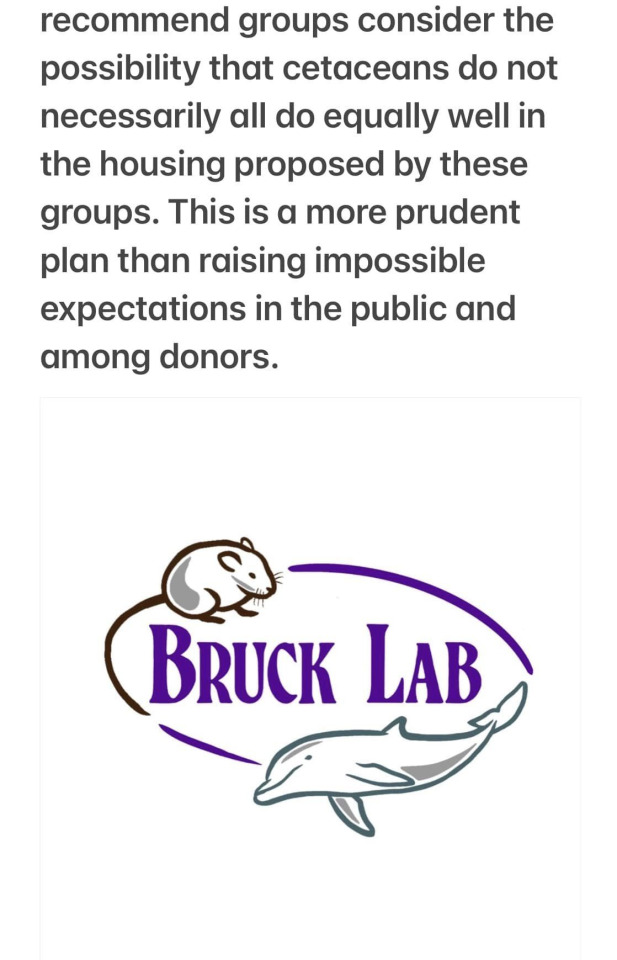
#dolphins#cetaceans#marine mammals#animal welfare#animal sanctuaries#national aquarium#aquariums#ara insanity#answered asks#judesaintfrncis
32 notes
·
View notes
Text
My hat is like a shark’s fin
How not to draw sharks, exhibit A:
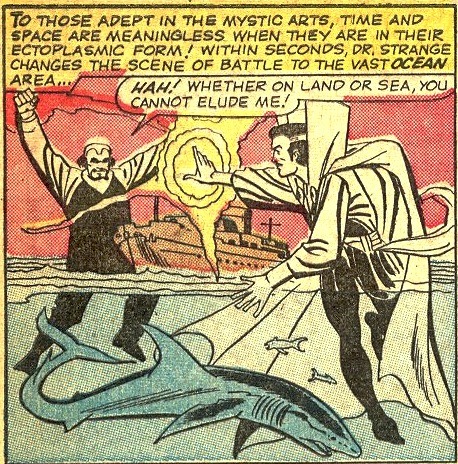
I mean for one, this poor guy (or gal...I do not know how to sex* a shark) looks like he’s having some kind of bad day. But for two - and in fact it may be related to the first - that back end looks wrong.
I’m no sharkologist (is there something more specific than a marine biologist? Do ichthyologists study cartilaginous fish?), but I can identify some types of fins. Sharks have many:
pectoral - located on each side, act like airplane wings (allows shark to steer up/down or side to side)
dorsal - on the back (includes both the main one that sticks out of the water to scare people in movies, as well as smaller ones further down the spine)**, provides stability to movement
pelvic - located on the underside of sharks, for changing direction when swimming
anal - (optional)*** for stability and balance
caudal - the one at the end
The caudal fin often tells you how fast and maneuverable a shark is, based on its shape and how symmetric the top and bottom half are to one another. Fast open-water sharks like Mako and Great Whites have very symmetric tails, but your average shark will have the top part longer than the bottom.
Below are examples of Great White, Whale Shark (the largest fish species alive), blacktip reef shark, and thresher shark. There are nearly 500 extant species - some of which don’t have the ‘typical’ shark shape (see: angel sharks) - so Odin knows I’m not going to show you all of them.
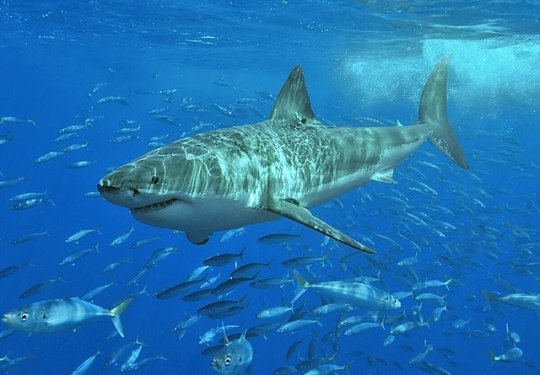
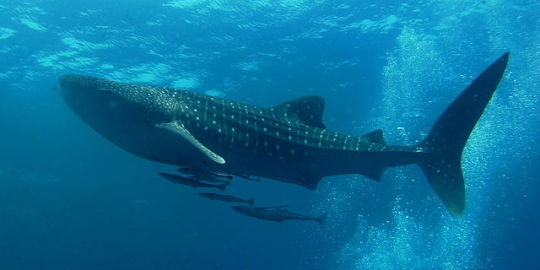
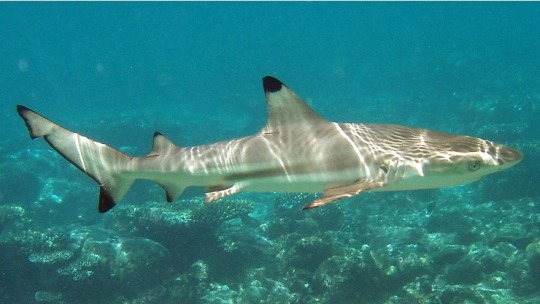

But there is one thing all these different caudal fins have in common. They’re oriented vertically, not horizontally, as is suggested in the comic panel.
That’s what marine mammals rock.

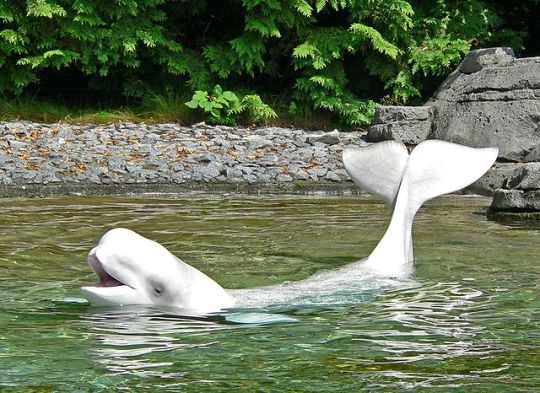
The reason for this is evolution. Cetaceans actually returned to the water millions of years ago, after developing land-based, 4-limbed skeletal structures. That included a gait wherein the spine moved up and down during movement, not side to side. That movement was preserved over the years as they lost their back legs, translating into perpendicular (relative to fish) tail fins - or, rather, “flukes”.
So our poor shark, whose day has been sadly interrupted by two dueling wizard spirits, has been suffering from a tail that has been completely twisted the wrong way ‘round for who knows how long.
Or the artists just don’t know how to draw sharks. Equally as likely.
And remember, folks. Sharks are friends. Not food.
_______________________________________________________________________
* But I do know chicken sexing - i.e. determining whether a chick is male or female - is a very difficult job.
** the taxonomic order Hexanchiformes - the most primitive order of shark - has only one dorsal fin
*** orders Squaliformes, Squatiniformes, and Pristiophoriformes don’t have an anal fin
Strange Tales #125
Image credits:
great white By Terry Goss, CC BY 2.5
whale shark By Abe Khao Lak - Own work, CC BY-SA 4.0
thresher shark By Thomas Alexander - Own work, CC BY-SA 4.0
black-tip reef Public Domain,
humpback By National Marine Sanctuaries - Whales, CC BY 2.0
beluga whale By Stan Shebs, CC BY-SA 3.0
4 notes
·
View notes
Note
Do you consider cetacean captivity bad science? The biologists I have worked with through my college career all agree it’s wrong. So like do you hit a point in your career when you realize it’s never going to work? And all of the science is against them? Because I don’t know many people with a PhD and are pro cap?
Gotta preface this with the usual - I’m not a scientist, just an artist who likes to read a lot. But imo-I’m not sure how you’re defining ‘bad science.’ The work that’s done re: captive cetaceans is valid in its own right as long as the study’s set up decently, but useful for anything besides the big bucket of “ah, that’s interesting” is another question entirely. I’m really concerned that behavior-focused studies on captive cetaceans may range from bad to misleading, because there’s basically 0 reason for them to act like their wild counterparts. (It’s interesting when they discover xyz is a thing, sure - but have we ever seen even an inkling of xyz in the wild? How do we know that xyz isn’t some demented byproduct of captivity? A lot of cetacean behavior as documented in wild animals has been noted as cultural in nature - very learned/observed (hence all the recent uproar about the growing evidences of their cultures.) Who knows what captive cetaceans are drawing from?) I also think the “helping wild whales/conservation” claims/etc are hogwash. I’ve not seen much that didn’t come out of the originating-org in question that supports those claims. Miserable failure of a beluga program? But it’s for conservation. Bucket o’Orcas? It’s helping the endangered killer whales. No. The only “useful/good science” thing that comes out of studying captive animals is basic physiological information. Which I’m sure is helpful to some larger studies - it’s a no-brainer that that kind of info is difficult-to-impossible to get in the field. But in the current context - where largely, a bunch of circuses keep cetaceans that occasionally might be studied - the value of such seems questionable vs. the long list of issues. And some of that physiological info seems like it may even be questionable because lifestyle is so different (eg metabolism study on captive orca. how different would the metabolism of such a sedentary animal be?) Combined with how these places insist they’re valuable for this purpose, while the output over decades is minimal…The highly-educated folks I’ve seen who are actively pro-captive seem to lean heavily towards the “dumb dolphin theory” side of things. Which I’m guessing demotes cetaceans sufficiently in their eyes to not see keeping them in the current situation as ‘wrong.’ I don’t know any PhDs who are pro-cap either, but I also haven’t looked very hard.The biologists and folks studying whales I’ve been around here in WA, seem to overwhelmingly view captivity/captive studies negatively too. I respect their opinions greatly, but in this state in particular I know the salt’s deep because of the industry history here. I always keep that in mind. (That isn’t to say such dismissively - rather there’s first-hand experience here, with the very real aftershocks that I don’t think have ever been properly acknowledged.) tl;dr it’s complicated. I think research might be the only valid “excuse” for captivity, but its present implementation is horrible basically to the point of needing to write the whole thing off because we clearly can’t do it right. I’m a little distressed that The Whale Sanctuary project is so opposed to any kind of research being done on its potential animals, because animals in a more natural setting who are having their needs better met are probably going to provide much better results than tank-animals…
85 notes
·
View notes
Text
Tips for Debating Orca Captivity
1. Stop saying shut down SeaWorld. This seems horrible for me to say, but it makes us seem unreasonable. They are a huge rescue group and we need to acknowledge that, while advocating for the relocating of orcas and dolphins to sea sanctuaries. They can keep doing their thing without them.
2. Recognize the other cetaceans in captivity. Blackfish has everyone riled up about orcas, which I love with all my heart, but nobody seems to think about all the dolphins, belugas, and porpoises in captivity. SeaWorld only said they'd stop breeding orcas because we're only talking about orcas (that and that a law was about to be made in CA banning their breeding)! Orcas are literally big dolphins, others suffer no less in captivity.
3. Stop only going after SeaWorld! This post is kind of focused on them but there are so many other marine parks that get no attention that have the same problems. Examples are the Miami Seaquarium, where the oldest captive orca is kept alone in basically a fish bowl, Marineland, and Six Flags has dolphins. More beneath the cut, LONG post.
4) Stop saying orcas live as long as humans. They don't. Females live 50 years, males live 30 years. Examples like Granny are rare, that's like saying humans live to 122 years (oldest person). When you give false info it discredits your argument. The actual captive age of death averages at 13 years at SeaWorld (not even including stillborns and ones that died under a year old), so age is still a valid argument.
5) Stop relying only on Blackfish. It's inspired so many people, but procaps think it's exaggerated propaganda, and it'll make you seem a lot more credible if you bring up some other sources. Instead of saying "x says this", do the research yourself. I found a list of all SeaWorld's past orcas are did the math myself to come to the average lifespan of 13 years, again, it makes you seem more credible. Research any anti-captivity "facts" you see. For example, SeaWorld doesn't deprive their orcas of food if they don't preform, and they don't capture cetaceans from the wild anymore. Again, it makes you seem uneducated and like you've been fed "propaganda" there are plenty of true awful things about orca captivity.
6. Take in opposing info if you've got the time. It's good for preparing rebuttals.
7. Advocate for wild cetaceans in danger. The Southern Resident Killer Whale pods are dying due to human activity, as well as several others. Taiji is still having massive dolphin slaughters every year.
8. Don't be rude. It's tempting to just say "ANIMAL ABUSER! FUCK OFF!" when dealing with these people but it won't change their minds. Have a conversation.
So, here are some good talking points. Keiko is a great example of how well sea pens can work out. His release deserves it's own post (technically a failure, but he wasn't a good candidate for release, lived a full life and died of natural causes under human care basically), but he lived in one for 4 years beforehand, and it did wonders for his health. The navy keeps dozens of dolphins in a facility made of sea pens just miles from SeaWorld San Diego. They're not a theoretical, we're already using them. Seaworld does separate mothers and offspring. Katina has had 5 of 7 taken from her. Every one of Kalina's was taken from her. Two of Takara's were taken. List these by name. Not every one was taken as a calf, but mother and offspring should never be separated. Their bonds last for life. SeaWorld does give their orcas drugs. Court documents prove that they give them benzodiazepines (anti-stress). Ex-trainers have reported constant antibiotics, which contributes to antibiotic resistance, which was probably a factor in the deaths of many orcas. There are also examples of antacids and antipsychotics. Their teeth wear down to the gums from chewing on metal and concrete, officials at Marineland in the documentary "Inside the Tanks" even say that they do it out of boredom. Procaps may say that this happens in the wild, which is true, but not down to the gums, and that is because of suction feeding and preying on rough skinned animals, which does not happen in tanks. The "they swim up to 100 miles a day" is accurate to my knowledge. SeaWorld has said that their orcas log in the water because "all animals rest" but dolphins (including orcas) don't ever fully sleep, they rest one part of their brain at a time. They are always moving in the wild. They log due to a lack of stimulation, same reason they chew on metal and concrete. They also repeatedly regurgitate food and beach themselves on the tank slideouts. This boredom caused repetitive behavior has a name: stereotypic behavior, or "zoochosis", because of how common it is in caged animals. They're so prone to this because of how incredibly intelligent they are. SeaWorld has done scientific studies on orcas, but have only done 51 since 1977, and only 32 published peer-reviewed relevant to wild orcas, and several are debatably not helpful to them. Since 1977. Their lifespan is significantly shorter than wild orcas. Most animals live /longer/ in captivity. While their new "educational" shows are informative, there are no benefits to their orcas. It's just "and this is a pectoral fin" instead of "wave to the audience!" I watched a video of one and they conveniently left out how far they swim and their lifespans, both impressive, notable facts. There have also been a large number of aggressive incidents other than Tilikum's kills (there’s got to be a better way to phrase that...), while orcas are incredibly peaceful in the wild, another sign of stress. There’s a significant amount of orca on orca aggression due to the forced “pods”, even deaths. Take a look at Morgan, in Loro Parque. I'm hugely anti captivity so this is just some advice for you guys.
#longest post ever#if this doesn't get notes i'm gonna cry#i spent so long on this#seaworld#sw#orcas#dolphins
93 notes
·
View notes
Note
2, 14, 25
2. Where do they prefer to read? On the sofa, in bed, at a table, on the porch, in a café?
!! isobel has a settee in velvet green sitting off-center in her bedroom , she likes reading there the most . especially with a wool blanket draped over her legs . for leisure reads , anyway . scientific journals and articles require her entire focus , so she would read these at her desk . she doesn't read in her bed because she thinks she's risking conditioning herself to associate reading with sleeping , and given her workload , she can't really have that . recently , however , she's been visiting a café to do her evening readings , and it's nice because it's not at all that noisy . she can read in just about every environment , but the onyx has her preferences .
14. How do they eat their popcorn? What do they put on it?
first of all , isobel hates cheese popcorn . she prefers either butter popcorn with salt , sour cream as it is , or ( salted ) caramel corn . she's one of the chosen few who can manage to pace eating the snack throughout the entire length of the movie .
25. What do they prefer to do in the summertime? Do they like going to the beach, do they prefer camping, staying in the city? Do they like to stay indoors and away from the heat?
for the past few years , isobel has spent her summers going on solo hikes in sweden , often gone for the length of a week or so . makes her feel something close to peaceful . for most of the trail she's alone , though she does run into other hiking groups along the way . last year , isobel visited the open - water sanctuary for beluga whales in klettsvik bay , iceland . ever since , she's been quite supportive of the organization responsible for them , making substantial donations and even adopting both of the belugas housed there . next summer , she plans on returning to new zealand to check out the orca research trust for herself before going back to her research . like most things , she keeps her interest in whale protection and ocean conservation a secret ( besides , it doesn't really come up in her conversations ) .
#rosegm#◟* tell me you haven’t lied to construct an honest history — ANSWERED . ❜ )#— ` the one with violets in her hand mostly goes astray / HEADCANON. ❜ )
0 notes